DRY CREEK BED
Managing Storm Water
Managing storm water has become an important aspect of site planning and garden design as extreme weather has increased in frequency and severity. Precipitation in the form of rain, snow, and hail needs somewhere to flow to protect buildings and infrastructure from this excess water. Dry creek beds and water gardens are a great way to direct water runoff from roofs, pathways, and pavement away from building foundations and out into the greater landscape. These gardens are also a strategy to help trap and hold water in years of persistent drought.
When the Hughes Education Center was built a great deal of effort went into designing the storm water drainage flow around the building. In a one-inch rainstorm the building’s roof can shed nearly 5,000 gallons of water! Close to a native ravine slope, erosion was a big concern as well as keeping the foundation and pathways dry. A gentle slope directs water from the gutters into the dry creek bed, where the water is allowed to pool and percolate deep into the soil. This garden wraps around the south and west walls from the back door to the parking lot entrance gate, collecting nearly half of the building’s stormwater runoff. Boulders and river rock help stabilize the topography to prevent erosion, and plants were selected for their deep roots and ability to survive standing water. Gardens like this should only hold surface water for 24-48 hours, any longer than that indicates compacted soil, a shallow soil profile, or a buildup of clay or sediment creating a layer of soil impassable to water.
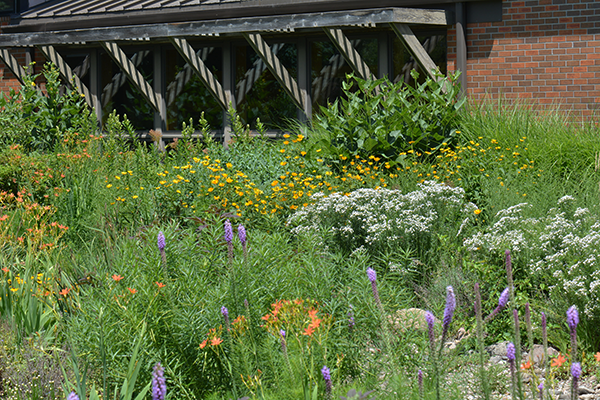
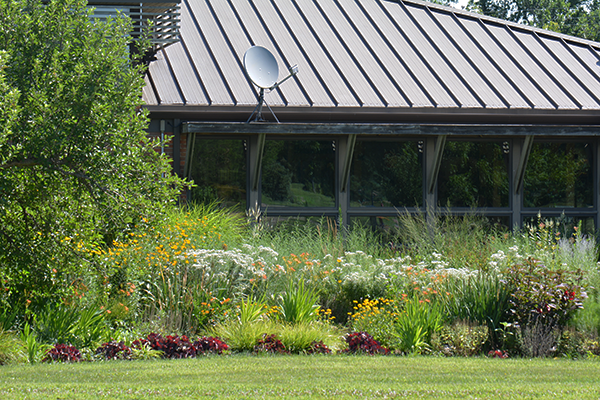
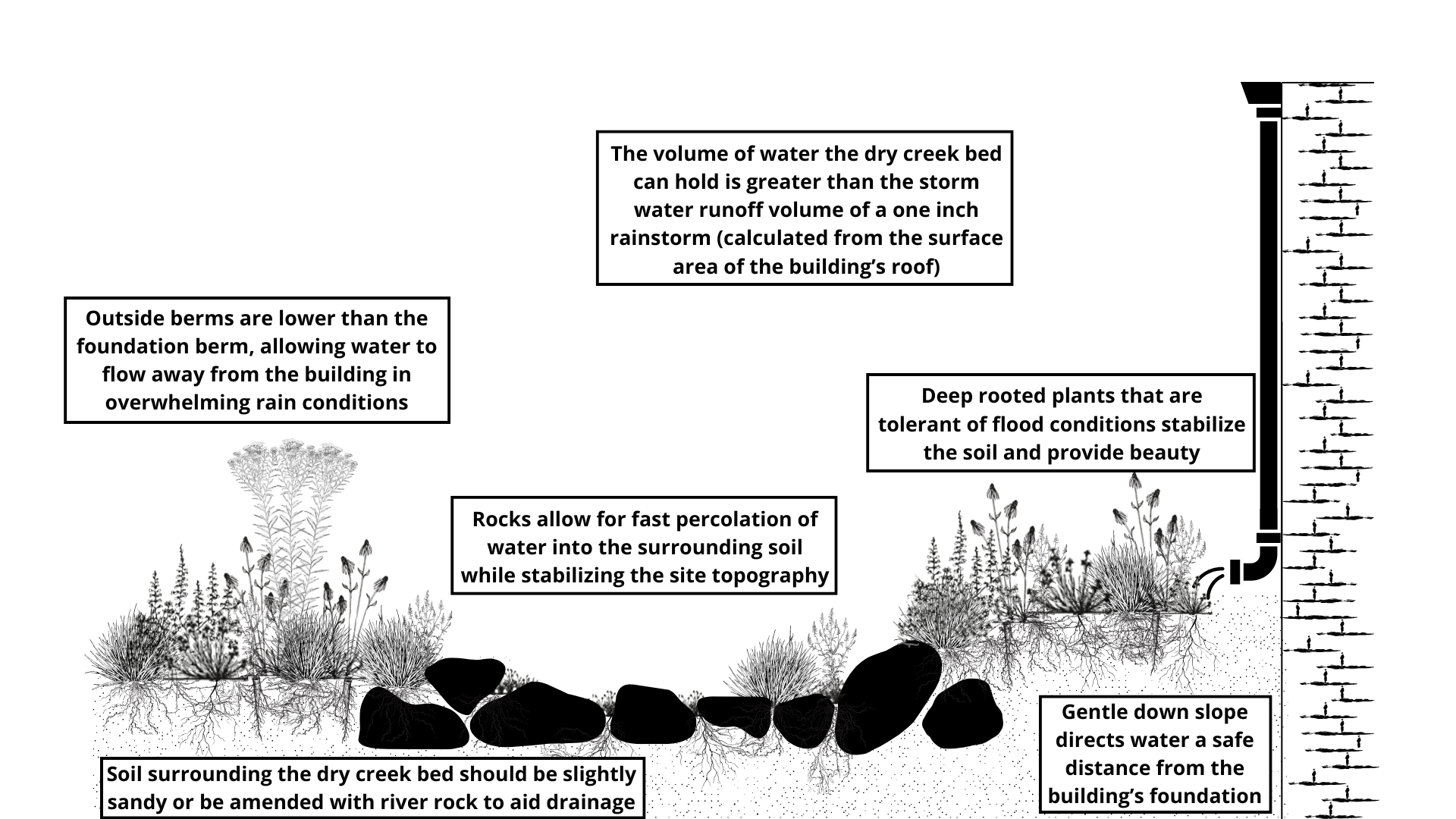
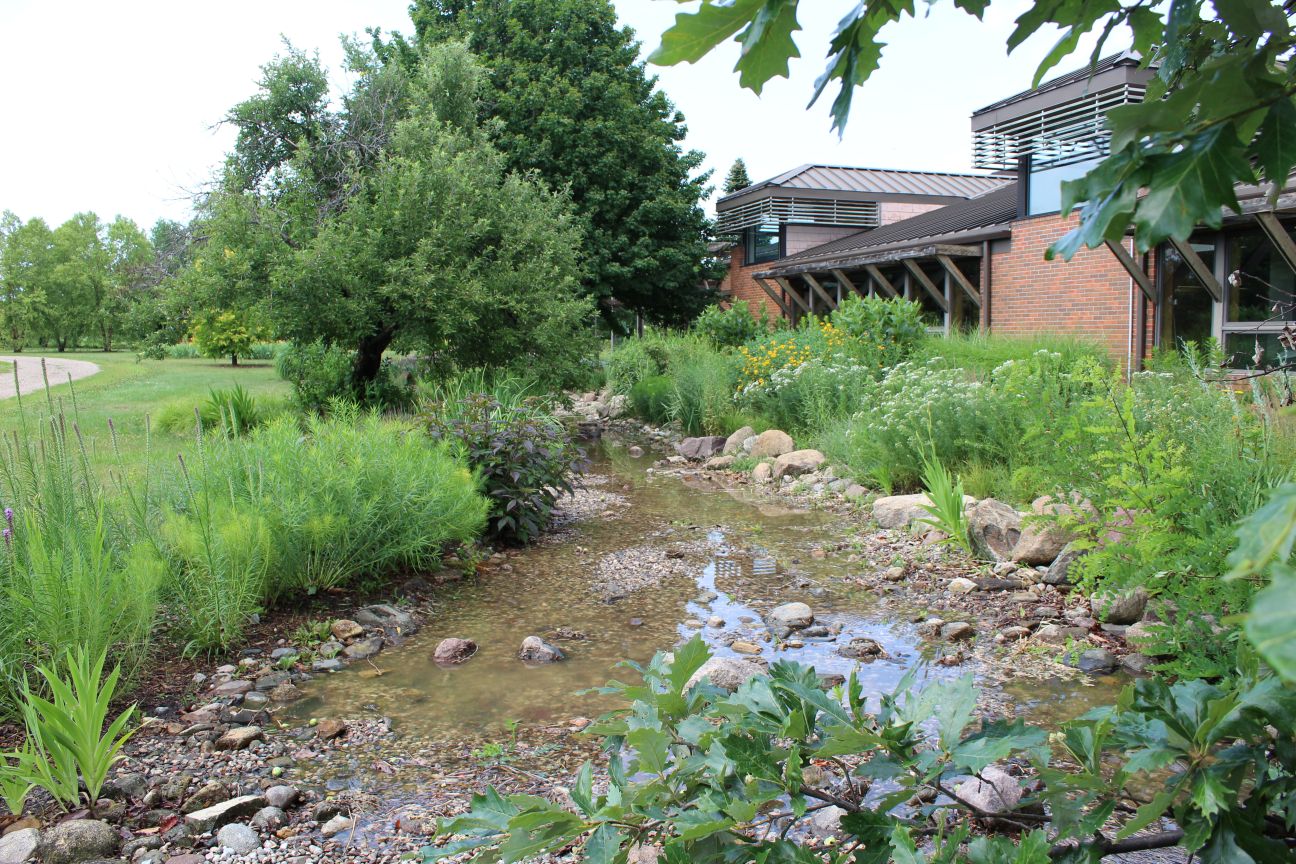
Building an Ecosystem
This style of gardening (often referred to as rain gardens) is extremely important for supporting local wildlife. Finding pools of fresh water in urban spaces is rare, so providing this service in your landscape can help your garden’s attractiveness to all kinds of creatures. The availability of water itself is enough to bring birds, amphibians, reptiles, insects, and mammals to your garden. But the way these gardens grow and are managed plays a key role too.
Often managed naturalistically, thick vegetation provides habitat and shelter. Lush plant growth can be food for herbivores big and small. Flowers with access to stored moisture bloom prolifically, providing nectar and seeds. Its not uncommon to see birds, butterflies, bees, frogs, and chipmunks exploring this dry creek bed.
Managing a Naturalistic Garden
Naturalistic gardens are managed very differently to traditional gardens. The fundamental idea about naturalistic gardens is that the whole landscape is living and dynamic, allowing for change in structure and function over time. Plants that were abundant and numerous in one year may completely disappear from the garden the next. Some plants may be more successful during a wet year while taking a back seat during drought years. The soil is completely covered with vegetation, making mulching unnecessary. Animals are allowed to function here, using the garden to survive rather than being sterilized of undesirable species. Plants are sometimes lost and having to be replanted, but the garden is alive with buzzing, rustling, and chirping.
One of the hardest parts of changing the gardening mindset is when it comes to weeding. The first several years of a naturalistic garden’s existence are the most important to establishing a beautiful and functional garden. Eradicating weeds (especially perennial species) can boost the vigor of the surrounding plants, limit competition, and prevent future weed issues. However, being able to distinguish a weed seedling from a desirable plant seedling can be difficult. Rather than your first instinct be to pull the unknown plant, see what it does first or learn its identity as best you can. Keeping the seedlings of desirable plants ensures the perpetuation and eventual filling of the garden. Other plants from the surrounding landscape may find their way into the garden too, adding diversity and beauty to the initial planting.
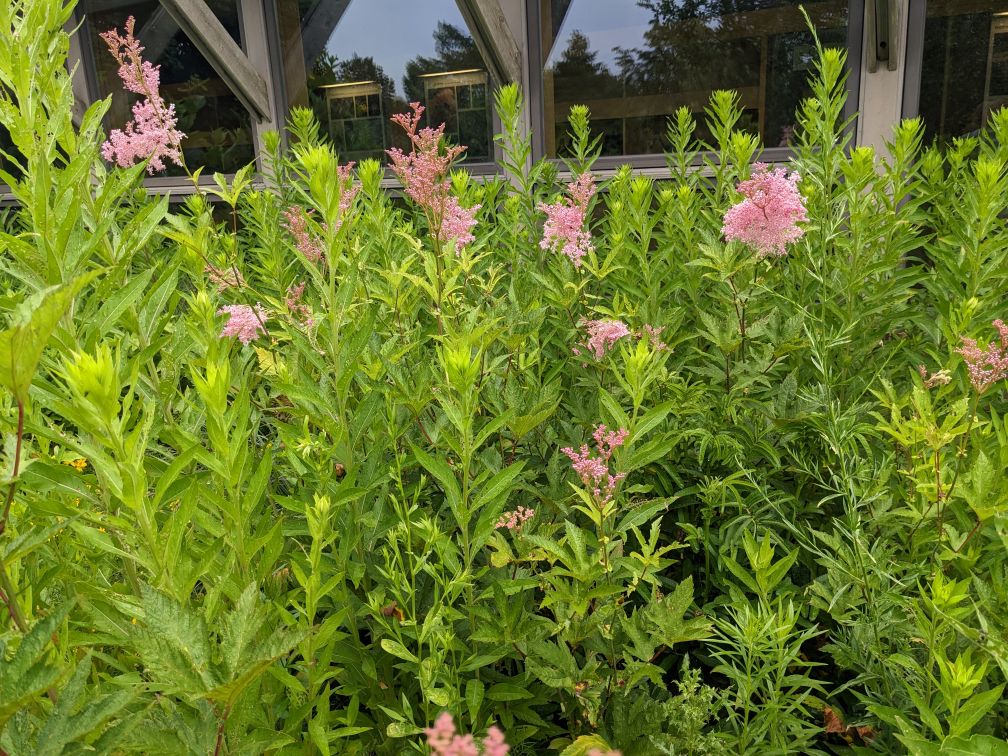
Allowing the plants you like to reseed is one way to help stabilize the population diversity in the garden. The seed bank composition can swing more heavily in favor of desirable plants, the garden becomes resilient to disturbance, and plants you like will move around the garden. In this instance, even allowing some plants to grow in between stones can be important by reducing the compaction of the soil under the dry creek bed and creating channels for water to percolate. If there are plants that become too aggressive or weedy, deadhead them or remove them from the garden all together to keep the garden’s legibility. If you’d like, you can even move aggressive plants to places in the garden where they will become stressed by the environment around them to check their behavior. For instance, fast spreaders make great plants to go directly under a gutter downspout. Plants that are becoming floppy or open up later in the season can grow slower or stronger close to the reflective heat from a wall, window, or boulder. Short groundcovers are helpful to fill in between larger plants, often referred to as “matrix” plants in naturalistic gardens.
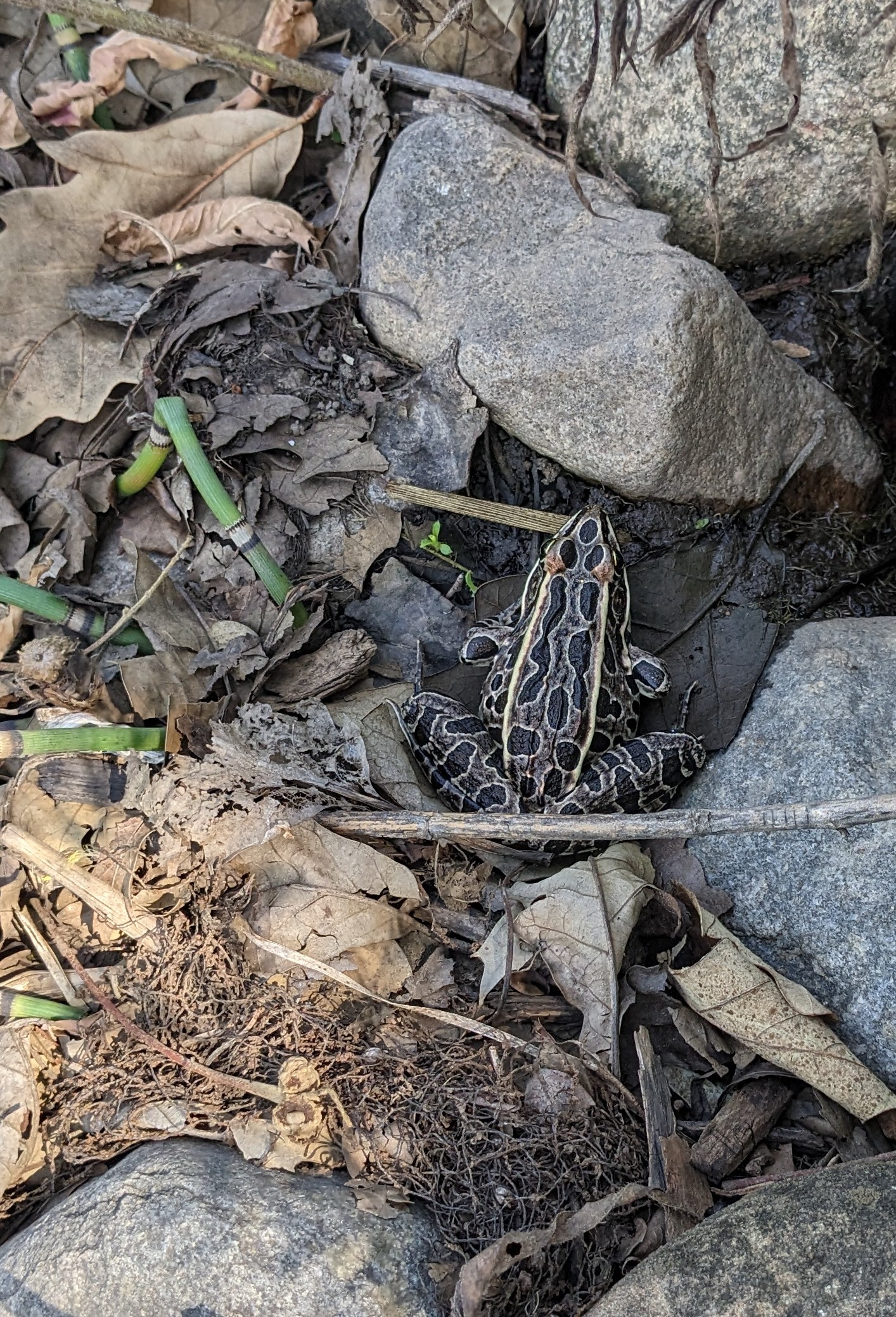
Overall, planting abundantly and diversly will prove to be the easiest way to start a naturalistic garden. Starting small with a few hundred square feet and a dozen species will help you learn the care and management of this type of garden. As you get more familiar and confident in your abilities, the garden can be expanded. When you decide on a species to plant, keep in mind that only planting one or two individuals won’t lead to the anticipated effect. Rather planting odd numbered groupings of plant types across the landscape is effective. Depending on the final size of the plant, groups of three or five for big plant varieties or nine to dozens of small ones will fill in the landscape, provide ample habitat, and create a natural population drift feel that you experience exploring natural spaces. For more affordable options try finding a nursery that sells plugs, starting your own plants from seed, or purchasing from mail order bare-root nurseries to get a large quantity for a good price.
This garden is mowed to three inches tall with a mulching mower in early spring. The exact timing depends on weather conditions. Generally, mowing is timed with the emergence of spring bulbs, particularly daffodils. Once the shoots reach three inches tall the air temperature has been warm enough for most overwintering creatures above the crowns of plants to have emerged for the year or have dropped to the ground. This allows for the fresh green shoots of the garden plants to be exposed to the sun and warm air, while also ensuring ground contact for seed. The plants mulch themselves with the previous year’s debris and build organic matter over time. The debris on the soil also leaves some shelter for creatures in the case of frost or late freezes.
History
The Dry Creek Bed was established in 2001 with the completion of the Hughes Education Center. Originally built with a few select specimens of showy perennials and big annual display beds, the garden was redesigned in 2016 as part of an Iowa Nursery and Landscape Association service project. This transformed the garden into a more naturalistic garden style, more typical of rain gardens. The garden was redesigned again in 2022 as part of 2020 derecho recovery and in anticipation of the Adele & Dean Bowden Treehouse Village project. The most recent redesign expanded the garden from its original footprint of just west of the Hughes Education Center to wrap around the south side of the building including the entrance and parking lot.
Back to Our Plants hompage
Plant List:
Herbaceous Perennials
Achillea filipendulina ‘Coronation Gold’ – Coronation gold Fernleaf yarrow
Achillea millefolium – Common yarrow
Aconitum carmichaelii ‘Arendsii’ – Autumn flowering monkshood
Ajuga reptans ‘Black Scallop’ – Black scallop bugleherb
Allium cernuum – Nodding onion
Allium giganteum – Giant onion
Allium schoenoprasum – Common chives
Allium x ‘Millenium’ – Millenium ornamental onion
Amsonia hubrichtii – Hubricht’s bluestar
Amsonia x ‘Seventh Inning Stretch’ – Seventh inning stretch bluestar
Aquilegia canadensis – Red columbine
Aralia cordata ‘Sun King’ – Sun king Japanese spikenard
Artemisia ludoviciana ‘Garden Ghost’ – Garden ghost prairie sage
Asclepias tuberosa – Butterfly milkweed
Athyrium niponicum var. pictum – Japanese painted fern
Baptisia x ‘Dutch Chocolate’ – Dutch chocolate false indigo
Baptisia x ‘Twilight Prairieblues’ – Twilight prairieblues false indigo
Brunnera macrophylla ‘Queen of Hearts’ – Queen of hearts Siberian bugloss
Calamintha nepeta ssp. nepeta – Lesser calamint
Calamagrostis x acutiflora ‘Eldorado’ – Eldorado feather reed grass
Carex flacca – Blue sedge
Carex grayi ‘New Moon Mighty’ – New moon mighty Gray’s sedge
Carex pensylvanica – Pennsylvania sedge
Chasmanthium latifolium – Northern sea oats
Chelone glabra – White turtlehead
Chelone lyonia – Pink turtlehead
Chrysanthemum x ‘Will’s Wonderful’ – Will’s wonderful chrysanthemum
Cimicifuga x ‘Chocoholic’ – Chocoholic black snakeroot
Coreopsis verticillata ‘Golden Showers’ – Golden showers tickseed
Coreopsis verticillata ‘Zagreb’ – Zagreb tickseed
Deschampsia cespitosa ‘Goldtau’ – Gold dew tufted hair grass
Echinacea pallida ‘Hula Dancer’ – Hula dancer pale purple coneflower
Epimedium x ‘Pretty in Pink’ – Pretty in pink barrenwort
Eryngium yuccifolium – Rattlesnake master
Eupatorium dubium ‘Little Joe’ – Little Joe Joe Pye weed
Filipendula rubra ‘Venusta’ – Queen of the prairie
Foeniculum vulgare ‘Rubra’ – Bronze fennel
Galanthus elwesii ‘Polar Bear’ – Polar bear snowdrop
Galanthus nivalis ‘Flore Pleno’ – Flore pleno double snowdrop
Geranium macrorrhizum – Bigroot geranium
Geranium pratense ‘Boom Chocolatta’ – Boom chocolatta cranesbill
Geranium x cantabrigiense ‘Karmina’ – Karmina cranesbill
Helleborus x hybridus – Lenten rose
Heuchera richardsonii – Prairie alumroot
Heuchera x ‘Apple Crisp’ – Apple Crisp coralbells
Heuchera x ‘Dolce Wildberry’ – Dolce wildberry coralbells
Heuchera x ‘Firefly’ – Firefly coralbells
Heuchera x ‘Mystic Angel’ – Mystic angel coralbells
Heuchera x ‘Primo Black Pearl’ – Primo black pearl coralbells
Hibiscus x ‘Cranberry Crush’ – Cranberry crush hibiscus
Hibiscus x ‘Midnight Marvel’ – Midnight marvel hibiscus
Hosta x ‘Curly Fries’ – Curly fries hosta
Iberis sempervirens ‘Snowflake’ – Snowflake evergreen candytuft
Iris spuria ‘Fontanelle’ – Fontanelle blue iris
Lazula acuminata – Hairy woodrush
Liatris spicata – Dense blazingstar
Liatris spicata ‘Kobold’ – Kobold dense blazingstar
Lilium michiganense – Michigan lily
Matteuccia struthiopteris – Ostrich fern
Molina arundinacea ‘SkyRacer’ – Skyracer moor grass
Monarda x ‘Jacob Cline’ – Jacob Cline beeblam
Monarda x ‘Raspberry Wine’ – Raspberry wine beeblam
Nepeta x ‘Walker’s Low’ – Walker’s low catmint
Oenothera biennis – Common evening primrose
Penstemon digitalis ‘IAarbo strain’ – Iowa Arboretum strain foxglove beardtongue
Penstemon digitalis ‘Onyx and Pearls’ – Onyx and pearls foxglove beardtongue
Penstemon digitalis ‘Pocahontas’ – Pocahontas foxglove beardtongue
Perovskia atriplicifolia – Russian sage
Persicaria amplexicaulis ‘Firetail’ – Firetail mountain fleece
Phlox divaricata ‘Blue Moon’ – Blue moon woodland phlox
Phlox paniculata ‘David’ – David garden phlox
Phlox subulata – Creeping phlox
Polygonatum odoratum ‘Variegatum’ – Variegated Solomon’s-seal
Pulmonaria x ‘Twinkle Toes’ – Twinkle toes liverwort
Pycnanthemum tenuifolium – Narrowleaf mountain mint
Pycnanthemum virginianum – Common mountain mint
Rudbeckia fulgida var. speciosa – Showy black-eyed Susan
Rudbeckia fulgida ‘Viette’s Little Suzie’ – Viette’s little Suzie black-eyed Susan
Rudbeckia x ‘American Gold Rush’ – American gold rush black-eyed Susan
Sanguisorba tenuifolia – Japanese burnet
Sedum x ‘Autumn Joy’ – Autumn joy stonecrop
Sesleria autumnale – Autumn moor grass
Sesleria x ‘Greenlee’s Hybrid’ – Greenlee’s hybrid autumn moor grass
Silphium perfoliatum – Cup plant
Silphium laciniatum – Compass plant
Sporobolus heterolepis – Prairie dropseed
Symphyotrichum ericoides ‘Schneegitter’ – White heath aster
Symphyotrichum novae-angliae – New England aster
Symphyotrichum novae-angliae ‘Elliot’s Pink’ – Elliot’s pink New England aster
Symphyotrichum novae-angliae ‘Elliot’s Purple’ – Elliot’s purple New England aster
Symphyotrichum oblongifolium ‘Lalla’ – Lalla aromatic aster
Symphyotrichum oblongifolium ‘Raydon’s Favorite’ – Raydon’s favorite aromatic aster
Symphyotrichum pilosum – Frost aster
Thalictrum dasycarpum – Tall meadow rue
Vernonia lettermanii ‘Iron Butterfly’ – Iron butterfly ironweed
Veronicastrum virginicum – Culver’s root
Viola sororia – Common blue violet
Viola sororia var. rubra – Pink common blue violet
Yucca filamentosa ‘Excalibur’ – Excalibur Adam’s needle
Woody Plants
Acer campestre ‘Queen Elizabeth’ – Queen Elizabeth hedge maple
Berberis thunbergia ‘Burgundy Carousel’ – Burgundy Carousel Japanese barberry
Cercis canadensis ‘Appalachian Red’ – Appalachian red redbud
Diervilla lonicera – Northern bush honeysuckle
Fagus sylvatica ‘Purple Fountain’ – Purple fountain weeping beech
Heptacodium miconoides ‘Tianshan’ – Tianshan seven-son flower
Hydrangea quercifolia – Oak-leaf hydrangea
Hydrangea paniculata ‘Bobo’ – Bobo panicled hydrangea
Hydrangea paniculata ‘Pinky Winky’ – Pinky winky panicled hydrangea
Hydrangea paniculata ‘Strawberry Sundae’ – Strawberry sundae panicled hydrangea
Malus x ‘Delicious’ – Delicious apple
Malus x ‘Red Barron’ – Red barron flowering crabapple
Metasequoia glyptostroboides ‘Gold Rush’ – Gold rush dawn redwood
Parrotia persica ‘Inge’s Ruby Vase’ – Inge’s ruby vase Persian parrotia
Pinus bungeana – Lacebark pine
Ptelea trifoliata – Common hoptree
Quercus bicolor – Swamp white oak
Rhus copallinum ‘Lanham’s Purple’ – Lanham’s purple shining sumac
Rosa rugosa ‘Hansa’ – Hansa rugosa rose
Rosa rugosa ‘Wild Spice’ – Wild spice rugosa rose
Spirea japonica ‘Magic Carpet’ – Magic carpet Japanese spirea
Ulmus parvifolia – Lacebark elm
